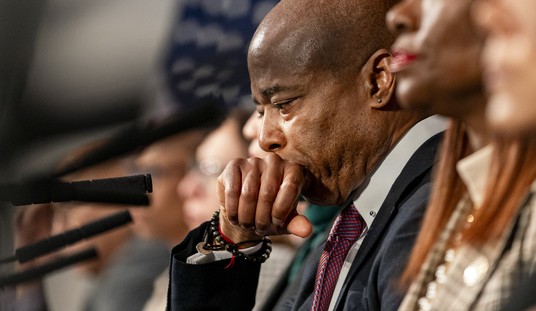Former Supreme Court Justice Harry Blackmun passed away in 1999, but his legacy as the author of Roe v Wade lives on — even if 55 million of its victims have not. Chapman Law professor Ron Rotunda recalls a reflection given by Blackmun 21 years later to a group of lawyers at an Aspen Institute conference, at which Rotunda took copious notes and quotes. Rotunda offers his own recollection of the strange conversation and circumstances in today’s Chicago Tribune, including Blackmun’s insistence that Roe was a doctor’s rights case, and not a women’s rights issue:
He would take no questions; he spoke from notes. His wife Dottie sat next to him, wearing a T-shirt that said, “The Supreme Question: Row vs. Wade.” Underneath it was a cartoon of a man rowing while another was wading in the water. I was surprised that she treated the topic as a joke. …
He objected that “academic opinion was generally adverse” to Roe as not grounded in law and said that he thought it was unconstitutional for the government to fail to fund abortions for poor people.
The Constitution gives federal judges lifetime appointments, so that they don’t feel compelled to follow public opinion in deciding cases. Blackmun, however, apparently did follow it. He was pleased that a “New York Times editorial was in favor,” but noted that letters to the editor “were divided.”
Roe “protected the woman’s right, with the physician, to get an abortion.” Blackmun emphasized the italicized phrase with his voice. He spoke of the case as a doctor’s rights case, not a woman’s right case. In Roe, Blackmun said, for the first trimester, “the attending physician, in consultation with his patient, is free to determine, without regulation by the state, that, in his medical judgment, the patient’s pregnancy should be terminated.” Note that the right was the right of the physician, whom Blackmun assumed was male.
Blackmun explicitly rejected the argument that “one has an unlimited right to do with one’s body as one pleases.” Instead, in Roe, Blackmun cited, with approval, Buck v. Bell, a 1927 case that approved of compulsory sterilization.
He closed by saying, “it has been exciting to be in the center of the issue so politicized by the political branches.” He added, “I make no apologies for the scholarship or result in the opinion.” His last words on Roe, “I’m really not too bad a guy after all.”
Blackmun expressed surprise at the amount of criticism over his decision and opinion, and the fact that he got picketed by protesters at a speech in Cedar Rapids, Iowa on one occasion. Blackmun sniffed at Justice Byron White’s impassioned dissent and reference to “raw judicial power,” referring to it as “emotional,” and bragging that he “made Byron eat those words” in later decisions.
Blackmun may have defended his legal reasoning to the bitter end, but he would be in a shrinking minority today. Even those on his own side think it was poorly decided, and for at least one of the reasons Blackmun stated in his defense. Ruth Bader Ginsburg said Blackmun went “too far, too fast,” and ended up catalyzing the pro-life community by essentially tying it to a right to privacy, as TPM reminds us today:
Her pique is that the Roe opinion, written by Justice Harry Blackmun, relies on a “right of privacy” under the 4th Amendment and emphasizes the right of physicians to practice medicine as they see fit. She prefers that abortion rights be recognized under the equal protection clause of the 14th Amendment, based on the view that having a child should be a woman’s choice.
Ginsburg has also said that the ruling damaged the growing movement for abortion rights by going “too far, too fast” and catalyzing the conservative pro-life community. Her words ring truer than ever today as the movement that was then on the decline has since has been successful at unwinding Roe protections in the Supreme Court and has dramatically curtailing abortion rights in red states, potentially nudging the issue back to the justices in the foreseeable future.
“That was my concern, that the court had given opponents of access to abortion a target to aim at relentlessly,” she told students at the University of Chicago Law School, as reported by The Associated Press. “My criticism of Roe is that it seemed to have stopped the momentum that was on the side of change.”
As John Fund notes, that makes it more or less a consensus in favor of seeing Blackmun’s activism as bad law and worse politics:
“One usually doesn’t speak about the conference of the U.S. Supreme Court,” Blackmun began as he read from his own notes, but he said he thought it was important to “promote understanding of the Supreme Court.”
“I decided it,” he said of the infamous case.
His decision lives with us today. NRO’s Ed Whelan has said Blackmun’s majority opinion “is rivaled only by Dred Scott as the worst opinion in Supreme Court history.” One of Blackmun’s own former clerks, Edward Lazarus (who described himself as “someone utterly committed to the right to choose [abortion]” and as “someone who loved Roe’s author like a grandfather”), aptly put it, “As a matter of constitutional interpretation and judicial method, Roe borders on the indefensible.”
But did Blackmun have any choice? A 14th Amendment-based ruling would have to take into account the equal application of law to both the woman and the human life that gets snuffed out in abortion. The scientific understanding of human life’s beginning at conception — when the sperm meets the egg and combines to create a unique organism that demonstrates its vitality through growth — was not as strong in 1973 as it is today, for a variety of reasons — better photography demonstrating embryonic development not least among them, but also the near-universal availability of ultrasounds and better messaging from the pro-life movement.
The ultimate question isn’t actually about religion or faith, but whether one human being has the right to kill another for the sake of convenience — which indeed would present a huge problem if considered under the terms of the 14th Amendment and equal protection under the law. So far, we’ve killed 55 million human lives on the scientifically ignorant premise that either they’re not really human or they’re not really alive, or the ethically bankrupt notion that one human life isn’t as important as another and can be tossed away when inconvenient. That’s the actual issue at stake in today’s March for Life.








Join the conversation as a VIP Member